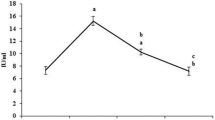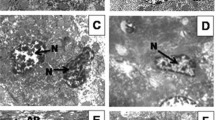Abstract
To clarify whether oxidative stress is involved in the development of hepatocellular preneoplastic foci induced by fenofibrate (FF), a peroxisome proliferator-activated receptor alpha agonist, male F344/N rats were fed a diet containing 6,000, 3,000, or 0 ppm of FF for 13 weeks after N-diethylnitrosamine initiation. Two-third partial hepatectomy was performed 1 week after the FF treatment. Histopathologically, the number of hepatocellular altered foci significantly increased in the FF-treated groups with a concomitant increase in the number of hepatocytes positive for anti-Ki-67 antibody, but the number and area of glutathione S-transferase placental form (GST-P)-positive foci decreased in these groups, as compared to those in the controls. Microarray analysis or quantitative real-time reverse transcription-polymerase chine reaction demonstrated the significant up-regulations of Aco and Cyp4a1 (genes related to lipid metabolism); Gpx2, Yc2, Cat, Cyp2b15, and Ugt1a6 (metabolic oxidative stress-related genes); Apex1, Mgmt, Xrcc5, Nbn, and Gadd45a (DNA repair-related genes); and Ccnd1 (cell cycle-related genes) in the FF-treated groups, and the significant down-regulations of Cyp1a2, Gsta2, Gstm2, and Gstm3 (phase I or II metabolism-related genes); Mlh1 and Top1 (DNA repair-related genes); and Cdkn1a, Cdkn1b, Chek2, and Gadd45b (cell cycle/apoptosis-related genes) in these rats. FF-treatment increased the activity of enzymes such as carnitine acetyltransferase, carnitine palmitoyltransferase, fatty acyl-CoA oxidizing system, and catalase in the liver, but not superoxide dismutase in the liver. In addition, 8-OHdG level in liver DNA, lipofuscin deposition in hepatocytes, and in vitro reactive oxygen species production in microsomes significantly increased due to FF treatment. These results suggest that oxidative stress is involved in the development of FF-induced hepatocellular preneoplastic foci in rats.


Similar content being viewed by others
Abbreviations
- FF:
-
Fenofibrate
- DEN:
-
N-diethylnitrosamine
- PPARα:
-
Peroxisome proliferator-activated receptor-alpha
- H2O2 :
-
Hydrogen peroxide
- H&E:
-
Hematoxylin and eosin
- GST-P:
-
Glutathione S-transferase placental form
- HAF:
-
Hepatocellular altered foci
- ROS:
-
Reactive oxygen species
- 8-OHdG:
-
8-Hydroxydeoxyguanosine
- DCFH-DA:
-
2′, 7′-Dichlorodihydrofluorescein diacetate
- RT-PCR:
-
Reverse transcription-polymerase chine reaction
- CAT:
-
Carnitine acetyltransferase
- CPT:
-
Carnitine palmitoyltransferase
- FAOS:
-
Fatty acyl-CoA oxidizing system
- DTNB:
-
5,5′-Dithio-bis-(2-nitrobenzoic acid)
References
Bayly AC, Roberts RA, Dive C (1994) Suppression of liver cell apoptosis in vitro by the non-genotoxic hepatocarcinogen and peroxisome proliferator nafenopin. J Cell Biol 125:197–203
Bock KW, Gschaidmeier H Seidel A, Baird S, Burchell B (1992) Mono- and di-glucuronide formation from chrysene and benzo(a)pyrene phenols by 3-methylcholanthrene-inducible phenol UDP-glucuronosyltransferase (UGT1A1). Mol Pharmacol 42:613–618
Cattley RC, DeLuca J, Elcombe C, Fenner-Crisp P, Lake BG., Marsman DS, Pastoor TA, Popp JA, Robinson DE, Schwetz B, Tugwood J, Wahli W (1998) Do peroxisome proliferating compounds pose a hepatocarcinogenic hazard to humans? Regul Toxicol Pharmacol 27:47–60
Corton JC, Lapinskas PJ, Gonzalez FJ (2000a) Central role of PPARalpha in the mechanism of action of hepatocarcinogenic peroxisome proliferators. Mutat Res 448:139–151
Corton JC, Anderson SP, Stauber A (2000b) Central role of peroxisome proliferator-activated receptors in the actions of peroxisome proliferators. Annu Rev Pharmacol Toxicol 40:491–518
Dybdahl M, Risom L, Moller P, Autrup H, Wallin H, Vogel U, Bornholdt J, Daneshvar B, Dragsted LO, Weimann A, Poulsen HE, Loft S (2003) DNA adduct formation and oxidative stress in colon and liver of Big Blue rats after dietary exposure to diesel particles. Carcinogenesis 24:1759–1766
Fukushima S, Wanibuchi H, Morimura K, Iwai S, Nakae D, Kishida H, Tsuda H, Uehara N, Imaida K, Shirai T, Tatematsu M, Tsukamoto T, Hirose M, Furukawa F (2004) Existence of a threshold for induction of aberrant crypt foci in the rat colon with low doses of 2-amino-1-methyl-6-phenolimidazo [4,5-b] pyridine. Toxicol Sci 80:109–114
Furukawa K, Numoto S, Furuya K, Furukawa NT, Williams GM (1985) Effects of the hepatocarcinogen nafenopin, a peroxisome proliferator, on the activities of rat liver glutathione-requiring enzymes and catalase in comparison to the action of phenobarbital. Cancer Res 45:5011–5019
Glauert HP, Beer D, Rao MS, Schwarz M, Xu YD, Goldsworthy TL, Coloma J, Pitot HC (1986) Induction of altered hepatic foci in rats by the administration of hepatic peroxisome proliferators alone or following a single dose of diethylnitrosamine. Cancer Res 46:4601–4606
Goel SK, Lalwani ND, Reddy JK (1986) Peroxisome proliferation and lipid peroxidation in rat liver. Cancer Res 46:1324–1330
Gschaidmeier H, Seidell A, Oesch F, Burchell B, Bock KW (1995) Formation of mono- and di-glucuronides and other glycosides of benzo(a)pyrene-3,6-quinol by V79 cell-expressed human phenol UDP-glucuronosyltransferases of the UGT1 gene complex. Biochem Pharmacol 49:1601–1606
Honkakoski P, Zelko I., Sueyoshi T, Negishi M (1998) The nuclear orphan receptor CAR-retinoid X receptor heterodimer activates the phenobarbital-responsive enhancer module of the CYP2B gene. Mol Cell Biol 18:5652–5658
Hegan DC, Narayanan L, Jirik FR, Edelmann W, Liskay RM, Glazer PM (2006) Differing patterns of genetic instability in mice deficient in the mismatch repair genes Pms2, Mlh1, Msh2, Msh3, and Msh6. Carcinogenesis 27:2402–2408
Huang CY, Wilson MW, Lay LT, Chow CK, Robertson LW, Glauert HP (1994) Increased 8-hydroxydeoxyguanosine in hepatic DNA of rats treated with the peroxisome proliferators ciprofibrate and perfluorodecanoic acid. Cancer Lett 87:223–228
Kasai H (1997) Analysis of a form of oxidative DNA damage, 8-hydroxy-2′-deoxyguanosine, as a marker of cellular oxidative stress during carcinogenesis. Mutat Res 387:147–163
Kastan MB, Zhan Q, el-Deiry WS, Carrier F, Jacks T, Walsh WV, Plunkett BS, Vogelstein B, Forance AJ Jr (1992) A mammalian cell cycle checkpoint pathway utilizing p53 and GADD45 is defective in ataxia-telangiectasia. Cell 71:587–597
Kawamoto T, Sueyoshi T, Zelko I, Moore R, Washburn K, Negishi M (1999) Phenobarbital-responsive nuclear translocation of the receptor CAR in induction of the CYP2B2 gene. Mol Cell Biol 19:6318–6322
Keeney DS, Skinner C, Travers JB, Capdevila JH, Nanney LB, King LE Jr, Waterman MR (1998) Differentiating keratinocytes express a novel cytochrome P450 enzyme, CYP2B19, having arachidonate monooxygenase activity. J Biol Chem 273:32071–32079
Kinoshita A, Wanibuchi H, Imaoka S, Ogawa M, Masuda C, Morimura K, Funae Y, Fukushima S (2002) Formation of 8-hydroxydeoxyguanosine and cell-cycle arrest in the rat liver via generation of oxidative stress by phenobarbital: association with expression profiles of p21(WAF1/Cip1), cyclin D1 and Ogg1. Carcinogenesis 23:341–349
Klaunig JE, Xu Y, Isenberg JS, Bachowski S, Kolaja KL, Jiang J, Stevenson DE, Walborg EF Jr (1998) The role of oxidative stress in chemical carcinogenesis. Environ Health Perspect 106:289–295
Klaunig JE, Babich MA, Baetcke KP, Cook JC, Corton JC, David RM, DeLuca JG, Lai DY, McKee RH, Peters JM, Roberts RA, Fenner-Crisp PA (2003) PPARalpha agonist-induced rodent tumors: modes of action and human relevance. Crit Rev Toxicol 33:655–780
Kraupp-Grasl B, Huber W, Putz B, Gerbracht U, Schulte-Hermann R (1990) Tumor promotion by the peroxisome proliferator nafenopin involving a specific subtype of altered foci in rat liver. Cancer Res 50:3701–3708
Lake BG, Kozlen SL, Evans JG, Gray TJB, Young PJ, Gangolli SD (1987) Effect of prolonged administration of clofibric acid and di(2-ethylhexyl)phthalate on hepatic enzyme activities and lipid peroxidation in the rat. Toxicology 44:213–228
Lake BG (1995) Mechanisms of hepatocarcinogenicity of peroxisome-proliferating drugs and chemicals. Annu Rev Pharmacol Toxicol 35:483–507
Ledwith BJ, Manam S, Troilo P, Joslyn DJ, Galloway SM, Nichols WW (1993) Activation of immediate-early gene expression by peroxisome proliferators in vitro. Mol Carcinog 8:20–27
Ledwith BJ, Johnson TE, Wagner LK, Pauley CJ, Manam S, Galloway SM, Nichols VW (1996) Growth regulation by peroxisome proliferators: opposing activities in early and late G1. Cancer Res 56:3257–3264
Markwell MA, McGroarty EJ, Bieber LL, Tolbert NE (1973) The subcellular distribution of carnitine acyltransferases in mammalian liver and kidney. A new peroxisomal enzyme. J Biol Chem 248:3426–3432
Marsman DS, Cattley RC, Conway JG, Popp JA (1988) Relationship of hepatic peroxisome proliferation and replicative DNA synthesis to the hepatocarcinogenicity of the peroxisome proliferators di(2-ethylhexyl)phthalate and [4-chloro-6-(2,3-xylidino)-2-pyrimidinylthio]acetic acid (Wy-14,643) in rats. Cancer Res 48:6739–6744
Marnett LJ (2000) Oxyradicals and DNA damage. Carcinogenesis 21:361–370
Matsuoka S, Rotman G, Ogawa A, Shiloh Y, Tamai K, Elledge SJ (2000) Ataxia telangiectasia-mutated phosphorylates Chk2 in vivo and in vitro. Proc Natl Acad Sci USA 97:10389–10394
McDonald ER III, El-Deiry WS (2000) Cell cycle control as a basis for cancer drug development (Review). Int J Oncol 16:871–886
Morgan DO (1995) Principles of CDK regulation. Nature 374:131–134
Nakae D, Mizumoto Y, Kobayashi E, Noguchi O, Konishi Y (1995) Improved genomic/nuclear DNA extraction for 8-hydroxydeoxyguanosine analysis of small amounts of rat liver tissue. Cancer Lett 97:233–239
Nishimura J, Dewa Y, Muguruma M, Kuroiwa Y, Yasuno H, Shima T, Jin M, Takahashi M, Umemura T, Mitsumori K (2007) Effect of fenofibrate on oxidative DNA damage and on gene expression related to cell proliferation and apoptosis in rats. Toxicol Sci 97:44–54
O’Brien M, Spear BT, Glauert HP (2005) Role of oxidative stress in peroxisome proliferator-mediated carcinogenesis. Crit Rev Toxicol 35:61–88
Parke DV (1994) The cytochromes P450 and mechanisms of chemical carcinogenesis. Environ Health Perspect 102:852–853
Peters JM, Aoyama T, Cattley RC, Nobumitsu U, Hashimoto T, Gonzalez FJ (1998) Role of peroxisome proliferator-activated receptor alpha in altered cell cycle regulation in mouse liver. Carcinogenesis 19:1989–1994
Pourquier P, Ueng LM, Fertala J, Wang D, Park HJ, Essigmann JM, Bjornsti MA, Pommier Y (1999) Induction of reversible complexes between eukaryotic DNA topoisomerase I and DNA-containing oxidative base damages. 7,8-dihydro-8-oxoguanine and 5-hydroxycytosine. J Biol Chem 274:8516–8523
Rao MS, Reddy JK (1987) Peroxisome proliferation and hepatocarcinogenesis. Carcinogenesis 8:631–636
Rao MS, Reddy JK (1996) Hepatocarcinogenesis of peroxisome proliferators. Ann N Y Acad Sci 804:573–587
Reddy JK, Lalwani ND, Reddy MK, Qureshi SA (1982) Excessive accumulation of autofluorescent lipofuscin in the liver during hepatocarcinogenesis by methyl clofenapate and other hypolipidemic peroxisome proliferators. Cancer Res 42:259–266
Roberts RA, James NH, Hasmall SC, Holden PR, Lambe K, Macdonald N, West D, Woodyatt NJ, Whitcome D (2000) Apoptosis and proliferation in nongenotoxic carcinogenesis: species differences and role of PPARalpha. Toxicol Lett 112–113:49–57
Rusyn I, Asakura S, Pachkowski B, Bradford BU, Denissenko MF, Peters JM, Holland SM, Reddy JK, Cunningham ML, Swenberg JA (2004) Expression of base excision DNA repair genes is a sensitive biomarker for in vivo detection of chemical-induced chronic oxidative stress: identification of the molecular source of radicals responsible for DNA damage by peroxisome proliferators. Cancer Res 64:1050–1057
Satoh K, Kitahara A, Soma Y, Inaba Y, Hatayama I, Sato K (1985) Purification, induction, and distribution of placental glutathione transferase: a new marker enzyme for preneoplastic cells in the rat chemical hepatocarcinogenesis. Proc Natl Acad Sci USA 82:3964–3968
Sato K (1989) Glutathione transferases as markers of preneoplasia and neoplasia. Adv Cancer Res 52:205–255
Seo KW, Kim KB, Kim YJ, Choi JY, Lee KT, Choi KS (2004) Comparison of oxidative stress and changes of xenobiotic metabolizing enzymes induced by phthalates in rats. Food Chem Toxicol 42:107–114
Senekeo-Effenberger K, Chen S, Brace-Sinnokrak E, Bonzo JA, Yueh MF, Argikar U, Kaeding J, Trottier J, Remmel RP, Ritter JK, Barbier O, Tukey RH (2007) Expression of the human UGT1 locus in transgenic mice by 4-chloro-6-(2,3-xylidino)-2-pyrimidinylthioacetic acid (WY-14643) and implications on drug metabolism through peroxisome proliferator-activated receptor alpha activation. Drug Metab Dispos 35:419–427
Sequeira DJ, Eyer CS, Cawley GF, Nick TG, Backes WL (1992) Ethylbenzene-mediated induction of cytochrome P450 isozymes in male and female rats. Biochem Pharmacol 44:1171–1182
Serron SC, Dwivedi N, Backes WL (2000) Ethylbenzene induces microsomal oxygen free radical generation: antibody-directed characterization of the responsible cytochrome P450 enzymes. Toxicol Appl Pharmacol 164:305–311
Shaban Z, El-Shazly S, Ishizuka M, Kimura K, Kazusaka A, Fujita S (2004) PPARα-dependent modulation of hepatic CYP1A by clofibric acid in rats. Arch Toxicol 78:496–507
Tsuda H, Fukushima S, Wanibuchi H, Morimura K, Nakae D, Imaida K, Tatematsu M, Hirose M, Wakabayashi K, Moore MA (2003) Value of GST-P-positive preneoplastic hepatic foci in dose–response studies of hepatocarcinogenesis: evidence for practical thresholds with both genotoxic and nongenotoxic carcinogens. A review of recent work. Toxicol Pathol 31:80–86
Waddell WJ, Fukushima S, Williams GM (2006) Concordance of thresholds for carcinogenicity of N-nitrosodiethylamine. Arch Toxicol 80:305–309
Yeldandi AV, Rao MS, Reddy JK (2000) Hydrogen peroxide generation in peroxisome proliferator-induced oncogenesis. Mutat Res 448:159–177
Author information
Authors and Affiliations
Corresponding author
Rights and permissions
About this article
Cite this article
Nishimura, J., Dewa, Y., Okamura, T. et al. Possible involvement of oxidative stress in fenofibrate-induced hepatocarcinogenesis in rats. Arch Toxicol 82, 641–654 (2008). https://doi.org/10.1007/s00204-007-0278-2
Received:
Accepted:
Published:
Issue Date:
DOI: https://doi.org/10.1007/s00204-007-0278-2




